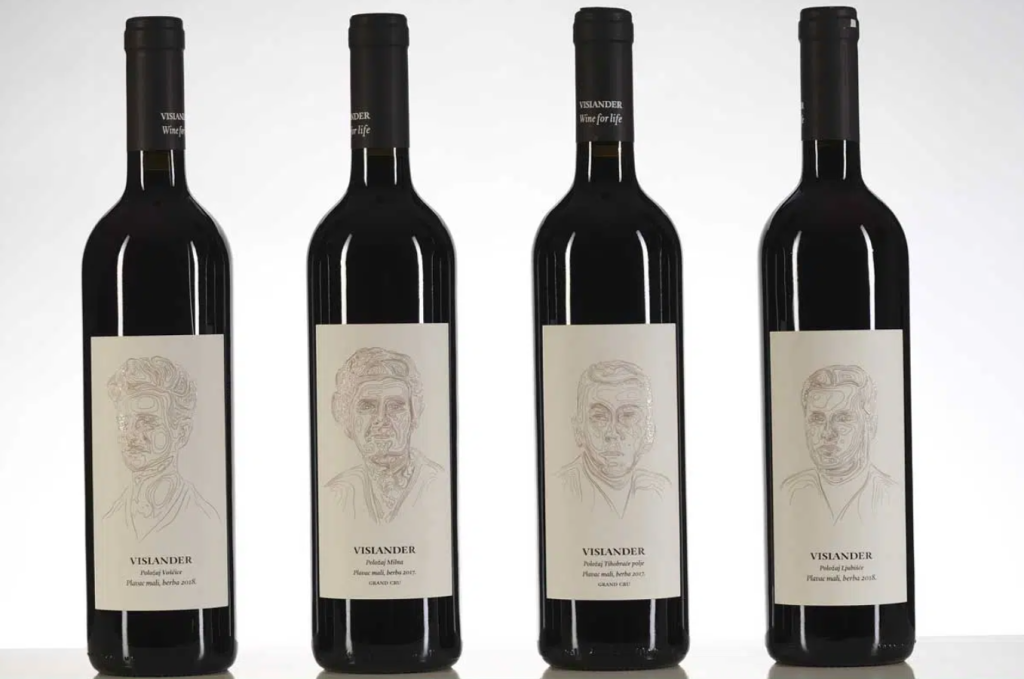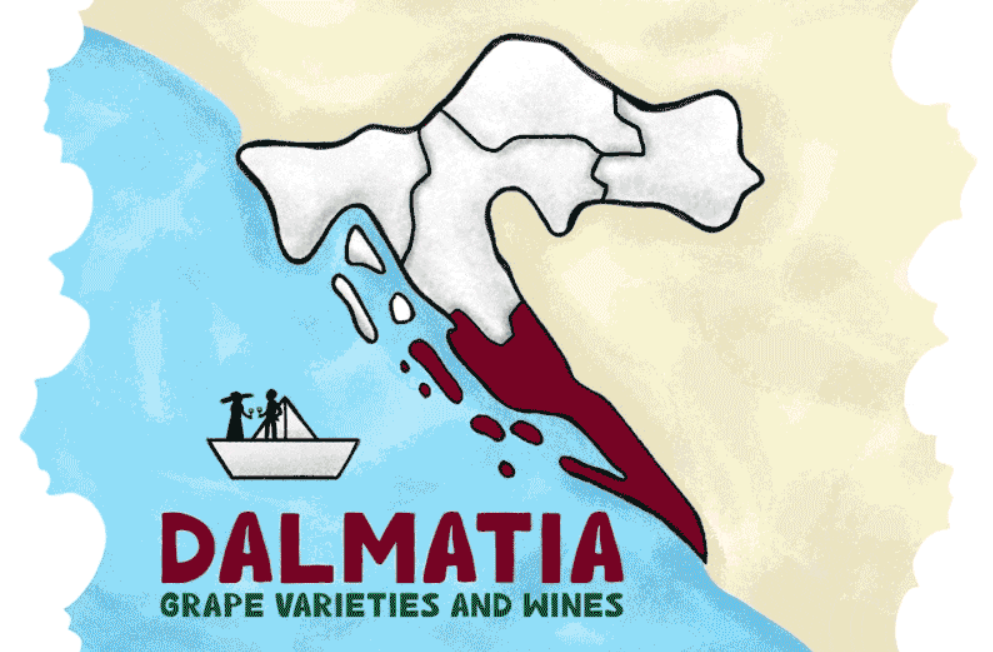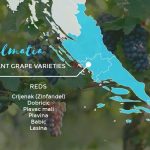March 08, 2024 – In this article, we delve into the world of Dalmatian wine. With the help of the Wine & more team, we will highlight 16 exceptional and indigenous grape varieties, that showcase the unparalleled diversity and quality of Croatian wines.

Key Feature of Dalmatian Grape Varieties
The Dalmatian coast has been cultivating vines since the time of the ancient Greeks and Romans, leading to the development of unique local wine varieties. This sun-drenched area along the Adriatic Sea provides an ideal terroir for a variety of indigenous grapes well adapted to its rocky terrains and maritime climate.
The Dalmatian wine region is shaped by its proximity to the Adriatic Sea and a Mediterranean climate, with specific areas such as the Pelješac Peninsula and Komarna, or Vis island, adding unique aspects to its terroir. Terroir signifies the environmental conditions in which grapes are grown, including soil, topography, and climate. In Dalmatia, there’s a rich mosaic of terroirs. The best way to introduce them is through the finely crafted wines.
Dalmatian White WINE Varieties
We can easily list many more of the 16 indigenous Dalmatian wine varieties, all of which are commercially cultivated.
Croatian wines, particularly those from Dalmatia, are known for their diversity, with most of these varieties found exclusively in this region.
Pošip: A Gem from Korčula
Pošip (POH-ship) is the most planted white variety in Dalmatia today. However, that wasn’t the case historically. Pošip variety was recognized and protected in 1967. on the south-Dalmatian island Korčula as the first Croatian white wine with denomination of origin.
It was accidentally discovered and grown only on the Korčula island. Today it has spread all over Dalmatia. As a consequence, Pošip varies greatly in taste depending on the particular terroir where it is cultivated, and the winemaking style. Modern Pošip wines tend to be lighter in body, refreshing, and fruity. While the traditional style is more opulent, and higher in alcohol, it can still be very much balanced and with the more herbal aromatic profile.
Pošip enjoys aging in wood, and there are even several “sur lie” notable mentions. Regardless of the style, Pošip is suitable for aging in the bottle. Most Pošip wines pair beautifully with flavorful seafood pasta dishes.
Vugava: The Hidden Treasure of Vis
Vugava (WOO-gah-vah) or Bugava variety is still a synonym for the charming island of Vis. Vugava is long known for its qualities, versatility in gastronomy, and overall potential. Vugava creates a structured white wine, with a firm body and uniquely Mediterranean aromatics. Fruit is usually backend with medicinal herbs and honeyed aromas.
Devoted to the remote island of Vis is the winery Vislander. VIslander makes their Vugava in several different vinifications:
- Vislander Bugava is a fresh Vugava fermented in inox. Bugava Antique is a modern reinterpretation of tradition. Fresh and easy-drinking, with a touch of cold soaking before and gentle battonage after fermentation in steel tanks.
- Bugava Premier is the most prestigious one, a more structured expression of a variety, refreshingly, with subtly intoxicating aromatics of stone fruit (pear, quince) and herbs (thyme, sage) touched by flowery and honeyed flavors.
Most Vugava wines pair beautifully with seafood, anything from raw sea urchin to seafood risotto, sprinkled with some goat cheese for example.
Debit: A Refreshing Delight
Debit (DEH-bit) derives its name from times when peasants were required to pay taxes to the governing body. To settle the debt (debitum, lat.), wine from this variety was accepted.
Debit was a very widespread variety in Dalmatia, especially in the northern part. Although tradition imposes a style of what is today known as an amber, or orange wine, it seems as if Debit is the best when refreshingly young, slightly greenish with a zingy citrus profile.
Little or no skin contact with temperature-controlled vinification in steel tanks proved ideal for Debit variety. The result is a light approachable, relaxing experience that still holds a distinct profile. Alcohol tends to be much lower compared to other Dalmatian wines.
Try it with oysters when very young or with the grilled sea bass or sea bream.
Maraština/Rukatac: A Heritage Reimagined
Maraština (mah-rah-shtee-nah) or Rukatac is a part of the Dalmatian heritage as it was once the most widespread white variety in Dalmatia. It is considered indigenous, although it is established that it is in fact the same variety as Pavlos in Greece or Malvasia bianca lunga in Italy.
Maraština is more suited for structured, age-worthy white wines. It can appear more robust with a bigger body and higher alcohol, but it can also be made as a refreshing wine. As a result, in a quest to make refreshing white wine suitable for summer sipping, Maraština is often blended with Debit or another variety of more pronounced freshness. That is more so in the northern Dalmatia.
In the southern part, it is often called Rukatac, and it is commonly made as a refreshing white. Yet, there are several examples of very successful “traditional take” on Maraština (Rukatac) in making today’s popular orange wine. Maraština can express the Mediterranean medicinal herbs and minerality perfectly. Pair Maraština with black risotto with squid ink, boiled seashells, or grilled sardines.
Grk: A Rare and Exquisite Find
Grk (gerk) is a true wonder from many perspectives. Now, Grk is probably the most sought-after white varietal wine from Dalmatia. It is distinctive and very rare. Grk originates from a small Lumbarda field on the island of Korčula. It’s the unique terroir of that sandy field that gives the variety its attributes.
Grk is made in a more refreshing style, but the power of Grk aromatic richness cannot be undone. Melon, pear, hints of honey, and flowery, Grk express a unique aromatic profile. Grk can be paired with heavier dishes, pasta with salmon, or even pork loin.
Kujundžuša: Delicate and Refreshing
Kujunduša (koo-yoon-zhu-shah) is another ancient Dalmatian variety that thrives due to modern winemaking. Kujundžuša is a tradition of the Dalmatian hinterland, especially in the Imotski area.
Delicate and refreshing, Kujundžuša may be difficult to pronounce, but it is super-easy to drink. Light body and tonic-like aromatics distinguish Kujudžuša from other Dalmatian or Croatian varieties. The result is a thirst quencher often served as an aperitif. Nice and cold, Kujundžuša pairs well with seafood appetizers, but also with lobster or shrimp.
Bogdanuša: A Gift from the Gods
Bogdanuša (bohg-dah-noo-shah) translates to “god-given”. This ancient pride of the Hvar island was nourished on today’s UNESCO-protected World Heritage Site. Stari Grad (Old Town) plain is the oldest continuously planted vineyard in the world. Here, since ancient Greeks, vines were grown and wine being made.
Today Bogdanuša is crisp and delicious, reborn in the style that suits the variety the most. Bogdanuša is usually greeny-yellow wine, light and fresh, low in alcohol, and citrusy aromatic with a floral accent. Cold seafood salads, fish carpaccio, or boiled fish are most perfect pairing with Bogdanuša.
Malvasia Dubrovačka: A Taste of History
Malvasija (mal-vah-see-ya) is different from Malvazija (mal-vah-zee-ya). Malvazija is actually Malvasia Istriana, an indigenous white grape of the Istrian peninsula. Dubrovnik Malvasija is the same variety as Malvasia delle Lipari. However, it is also a part of the cultural heritage of winemaking in the Dubrovnik area since forever and thus considered indigenous.
Ripe fruitness and opulency, with an important touch of intoxicating floral scent, are notorious features of this variety. Many modern-made examples also showcase the complexity of this low-yielding variety. Due to its nature, Malvasija Dubrovačka pairs excellent with a riverfish, or a veal.
Zlatarica: A Delicate Pleasure
This demanding variety has also recently been revitalized. Zlatarica is indigenous in the Dalmatian hinterland, especially in the Vrgorac area. Very delicate in the vineyard, shows similar delicacy in the wine glass. Lean body with a citrusy heart, Zlatarica shows dynamic on the palette and fresh character. This seductive summer sipper as we know it today was almost extinct. Thanks to a vision of a few winemakers, Zlatarica was revitalized and commercially grown. Zlatarica will pair beautifully with fish spread or a pate.
Dalmatian Red WINE Varieties
In Dalmatia, red wines are celebrated for their bold flavors and distinctive character, reflecting the region’s rugged terroir and winemaking tradition.
Plavac Mali: The King of Dalmatian Reds
Plavac Mali (Plah-vatz Mah-lee) is the most planted red variety in Croatia. With Plavac Mali we can witness exactly how terroir and microclimate conditions influence the grape, and consequently, the wines. Bold, strong, and tannic, Plavac can achieve greatness unlike any other Croatian variety.
The aromatic profile is different. Many orthodox Plavac wines express unique aromas reminiscent of carob, sage, and dried figs, but also either red or darker fruit, or both. Plavac Mali differs depending on the specific terroir, and growing conditions.
Traditionally, the best vineyard positions for Plavac Mali were considered to be the southern slopes of Dalmatian islands and land. Such are
- the southern positions on Pelješac peninsula (famous Dingač and Postup),
- southern slopes on the island of Hvar (Ivan Dolac, Sveta Nedjelja),
- southern slopes of Brač island (Murvica, Stipančić),
- now slopes of Komarna etc.
This is the story of triple insulation, where Plavac receives the sun directly, reflecting from the white stone in the topsoil, and reflecting from the sea.
For example, Plavac from Komarna apellation is rarely overripe though it is often very concentrated and tannic, but balanced. The same is showing for Plavac from Stipančić position on the Brač island.
Traditionally, it was known that Plavac Mali from Vis island can hold extremely high alcohol better than any other Plavac. Vis Island is truly different from other Dalmatian islands.
Most of Vis island’s vineyards are inside the island, on the carst fields. And, each field carries different information to the grape grown. Ideal examples are the four different Plavac Mali wines, made by Vislander Winery:
- Plavac Mali from Milna field,
- Plavac Mali from Tihobraće field,
- Plavac Mali from Voščice field,
- Plavac Mali from Ljubišće field.

Korčula is also different from other Dalmatian islands. It is covered with plenty of forests, so it earned the name “black island”. And Korčula is a black island of white wines.
That is also untypical for Dalmatia because Plavac Mali is usually the most planted variety. For example, Plavac Mali from Lumbarda was greatly different in style and character. It carried the same recognizable aromatic profile, only in a much thinner body. The tannins are also softer and the weight is supported by lively freshness, often a crucial issue for Plavac Mali.
Plavina: A Lighter Alternative
Plavina (plah-vee-nah) is, after Plavac Mali, the second most planted red variety in Dalmatia. There are similarities between Plavina and Plavac Mali, but Plavina is generally softer, and not as full-bodied, balanced, and versatile red wine.
Plavac and Plavina are close relatives, both are offspring of Tribidrag (or Crljenak Kaštelanski) who became famous under the name Zinfandel. In the northern Dalmatia, Plavina is increasingly used in blends, or as a Rose wine. However, more and more is Plavina recognized as a Dalmatian take on Mediterranean red wine in character, only lighter and balanced.
Tribidrag: Unveiling a Hidden Gem
Tribidrag or Crljenak Kaštelanski (tser-yen-ack Kah-shtel-lahn-skee) is a “rediscovered” grape. In all honesty, it would probably be extinct by now in Dalmatia, if it weren’t for the discovery. In 2001. it was discovered that the famous Zinfandel is in fact, genetically identical to Tribidrag.
With the origins of Zinfandel revealed in an obscure and forgotten grape, many started to think are there more of such biological treasures in the old Croatian vineyards? Also, many have decided to plant the Tribidrag to discover its potential.
As it shows so far, it is much fruitier in profile than its offspring Plavac Mali. However, it is also less jammy compared to many Californian examples. So, what you can expect from Tribidrag is a full-bodied red, a concentration of fruitness, spiciness, good tannin and overall structure for aging, and sometimes a minerality in the aftertaste.
Babić: A Primošten Classic
Babić (bahb-itch) variety was historically almost exclusive to tiny pieces of land in the Primošten area. The most famous would be Bucavac (across the Primošten town), with old bushes on a fistful of earth stolen from the stone that was then used to form stone lace on the ground.
To this day, Babić is mostly grown only in Šibenik county in northern Dalmatia. Little black giant from Primošten inspired winemakers to recreate the ideal. That ideal would be The Babić. A mythical red wine elixir. Despite the myth, Babić is not necessarily a full-bodied thick red wine of impenetrable color.
It is a variety of grace and delicate beauty with an aromatic profile of unique marasca cherry fruit. Certainly, there are examples of more concentrated and overripe fruitness, but Babić is somehow always elegant. With preserved freshness, and not as tannic. Rich mouthfeel with earthiness and minerality in the aftertaste, but not too heavy to the palate – that is a Babić wine of ideal balance.
Lasina: Dalmatian Pinot Noir
Lasina (lah-see-nah) is something completely different. This variety doesn’t achieve the wines one would normally expect in Dalmatia. Probably every region in the world has it’s own “Pinot Noir” and Lasina would be the “Dalmatian Pinot Noir”.
If all it takes are silky tannins, transparent color, and a lighter body, then of course. It is more similar to Pinot Noir than any other Dalmatian variety. However, Lasina is quite unique. Beneath the gentle texture is a dried (red) fruit and floral substance, juiciness that disperses on the palate, and spicy aftertaste.
The reason why Lasina is a very rare find lies in the endemic properties of the region it grows in. Lasina is almost exclusive to the Plastovo region in northern Dalmatia or other inland parts of the Dalmatian hinterland. It benefits from continental climate influences and diurnal temperature differences in these areas.
Dobričić: Revival Awaits
Dobričić (Doh-bree-cheech) came to the spotlight at the same time when Tribidrag was discovered to be genetically identical to Zinfandel. In a quest to find the other parent of Plavac Mali, Dobričić was the answer. Dobričić truly shares many of the same characteristics with Plavac Mali, but with the latest genetic markers, the direct parental connection was abandoned.
Its dark color was historically used to improve the desired appearance of lighter-colored red wines. There are also plenty of tannins, and low acids, similar to Plavac grape. Unlike Tribidrag, Dobričić is hard to find except on Šolta island. Considered native to Šolta, Dobričić is slowly becoming one of the signature grapes of Dalmatia, with its earthy notes, balsamic presence, and mineral finish.
Darnekuša: A Rare Delight
Mineral and savory, Darnekuša is truly a rare variety. Structurally different from what is expected in Dalmatia, Darnekuša was traditionally used to improve the lack of acidity in Plavac Mali wine from Hvar.
Less colored, more freshness and vitality (Darnekuša wines were proven to deepen and develop with aging in bottle), Darnekuša is an elegant counterpart to often robust Dalmatian reds.
conclusion
While these 16 varieties offer a glimpse into the rich tapestry of Dalmatian wine, they are merely a starting point for exploration. With countless other indigenous grapes waiting to be discovered, Dalmatia remains a treasure trove for wine enthusiasts seeking unique and unforgettable experiences. Cheers to the diversity and distinctiveness of Croatian wine!
NOTE: The article was originally written at wineandmore.com












